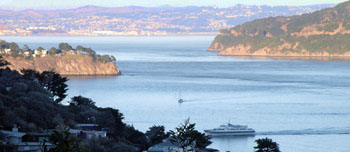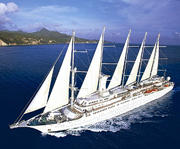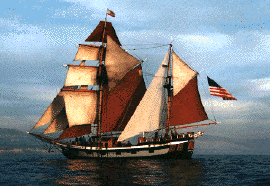Tall Ships Gold Rush Race Hawaiian Chieftain

° Index ° Eagle ° Guayas ° Hawaiian Chieftain ° Kaiwo Maru ° Deep Sea Derby, 1852 ° Levy's Log
Sail San Francisco 1999

I've kayaked San Francisco Bay and environs in all weather and around the clock. I've paddled in the wake of a full moon, had the company of seals, a whale, bat rays (Tomales Bay). Paddled under three bridges in one day (from Sausalito, under the Golden Gate, along San Francisco's shoreline to the Bay Bridge. Thence under the Bay Bridge and along the East shores of the Bay to the Richmond-San Rafael Bridge and back to Sausalito). That trip took roughly 8 hours.
1800 hours:
 With the exception of a short journey on the elegant Windstar, my first voyage under sail in a vessel over 45 feet was on the Hawaiian Chieftain, berthed at Sausalito across the Bay from San Francisco.
With the exception of a short journey on the elegant Windstar, my first voyage under sail in a vessel over 45 feet was on the Hawaiian Chieftain, berthed at Sausalito across the Bay from San Francisco.
The Hawaiian Chieftain, a gaff-rigged topsail ketch, is a replica of a typical European merchant trader of the turn of the nineteenth century. Her hull shape and rigging are similar to those of Spanish explorer's ships used in the expeditions of the late eighteenth century along the California coast.
I’d often seen the Chieftain on the Bay while kayaking around Angel Island or Alcatraz during sunsets or full moons. Her rust-colored sails glow during late afternoon light, and I’d wondered what it would be like to sail on her. Because of my volunteer work for the Gold Rush Sail/Tall Ships Parade, I was invited to walk her decks along with captains and consuls from countries participating in the Tall Ships events in San Francisco.
 1900 hours: As we left shore, a feeling of elation and exhilaration set in. As the sails were set, I experienced a new sensation. I’d never particularly liked sailing on smaller vessels – perhaps because it was impossible to walk the deck, or perhaps of too many hours floundering in the Bay due to lack of wind, and/or perhaps of the irresponsibility of some (some, not all) of the helmsmen. Many times, I’d paddled my 19 foot-long Nimbus Horizon past sailboats stalled mid-course as sailors shouted: "Hey, will you tow us?" Other times, I’d have to paddle fast to get out of the way of an errant sailor. Also sailing is sometimes nothing more than a picnic on water – too many people on board, too much food, too much beer, and no "rules of the road.". I remain shocked that there is no testing and subsequent licensing of sailors, particularly on a body of water as dynamic as San Francisco Bay.
1900 hours: As we left shore, a feeling of elation and exhilaration set in. As the sails were set, I experienced a new sensation. I’d never particularly liked sailing on smaller vessels – perhaps because it was impossible to walk the deck, or perhaps of too many hours floundering in the Bay due to lack of wind, and/or perhaps of the irresponsibility of some (some, not all) of the helmsmen. Many times, I’d paddled my 19 foot-long Nimbus Horizon past sailboats stalled mid-course as sailors shouted: "Hey, will you tow us?" Other times, I’d have to paddle fast to get out of the way of an errant sailor. Also sailing is sometimes nothing more than a picnic on water – too many people on board, too much food, too much beer, and no "rules of the road.". I remain shocked that there is no testing and subsequent licensing of sailors, particularly on a body of water as dynamic as San Francisco Bay.
1930 hours: I realize that sailing on a vessel such as the Hawaiian Chieftain is a whole other world. While the Hawaiian Chieftain staff takes excellent care of its passengers by providing ample provision, great skill and knowledge is mandatory to maneuver such fine, large vessels. Mistakes in such a ship would be costly to life and limb, so the Captain and crew pay close attention to the elements.
This was a somewhat balmy night (for San Francisco Bay in June), clear, a light wind from the West, the setting sun changing the Bay's colors to silver, then orange, and finally purple. Because I’m used to the cold air blowing over the Bay, I didn’t bundle up as did most of the passengers, but stayed on deck in a T-shirt.
Fernando Flores, Consul General of Ecuador asked "aren’t you cold?" I shrugged and said "probably, but it doesn’t bother me." He and others shivered in the wind. I thought about the many lessons learned from observing bays, oceans and wind during kayaking tours. Was this a lesson: Perhaps if one doesn’t resist the cold by trying to not be cold, and just accepts the fact that one is cold, it isn’t bothersome.
Does that make sense?
I was surprised as how smoothly the ship glided across the Bay. She is quite beamy in comparison to her length, so perhaps that helped. I wanted to know everything about her, about ships, about sailing and realized that a new life's journey was beginning.
Tall Ships: The Fleet for the 21st Century
Thaddeus Koza
This new and revised edition includes photographs and descriptions of over 175 vessels, including the major class 'A' ships along with many class 'B' and 'C' vessels from around the world. These are the tall ships of today and can be seen at major world ports during the years. Organised alphabetically, the book offers an impressive photograph of each vessel, supplemented by photographs of details ranging from figure heads and binnacles to flags and rigging. The text describes each ship featured, its history and notable events under sail, along with its technical specifications. An ideal book for everyone interested in these elegant vessels, their enduring history and traditions.
Tall ship rigging includes: Two-Masted Schooners, Brigantines, Topsail Schooners, Full-Rigged Ship, Barquentine, Three-Masted Schooners, Brig.

Sam Jefferson
More than 200 paintings, illustrations, and thrilling descriptions of the adventures and races on the water. First-hand accounts, newspaper reports and log entries. Racing out to the gold fields of America and Australia, and breaking speed records carrying tea back from China, the ships combined beauty with breathtaking performance. Speed was of the essence in order to reach port with goods first.
American Built Clipper Ship
1850-1856 Characteristics, Construction, Details
William L. Crothers
More than 35 years exacting research, this book presents detail of 152 clippers that comprise the culmination of the shipbuilder's art. Every facet of clipper ship design and construction is covered, including wood species, scantlings, fastenings, midship sections, interior living areas, and details of scarphs, keels, stem- and sternpost assemblies, frames, timbers, and bracing, with some 160 intricately drawn illustrations by a man whose unequaled work has earned him a national following among modelers and maritime museum directors.
Pacific Marine Review:
The National Magazine Of Shipping, Volume 19
Pacific American Steamship Association.
A reproduction of a book published before 1923.
China Tea Clippers
George Frederick Campbell
The history of the China tea clippers is examined, especially their struggle in the 19th century for economic survival in the face of the steamships. It also details advances made in design, hull construction, rigging, sail plans and deck arrangements.
American Clipper Ships:
1833-1858
Adelaide-Lotus
Volume 1 covers all American Clipper Ships built from 1833-1858 whose names begin with the letters A through L, and Volume 2 covers from M through Y. The criteria used to define a Clipper Ship, which is a ship "of peculiar construction, designed for great speed rather than for capacity." (p.v) The authors consider the Ann McKim launched at Baltimore in 1833 to be the first Clipper, and the era of the Clipper to be over by 1858 with the launching of The Star of Peace at Newburyport. The books are basically listings of all 352 known Clipper Ships arranged alphabetically. Clipper ships, in addition to being exquisite vessels, were beasts of burden. Their loaded holds raced around the world; first goods in a foreign port -- San Francisco being a "foreign port" at that time -- brought in the highest returns.
American Merchant Ships:
1850-1900
(Dover Maritime)
Frederick C. Matthews


Willis John Abbott
A chronicle of the high courage, the reckless daring, and oftentimes the noble self-sacrifice of those who use the Seven Seas to extend the markets of the world, to bring nations nearer together, to advance science, and to cement the world into one great interdependent whole. Willis John Abbott (1863-1934), American journalist and author of several maritime books, gives a detailed account of the history of merchant shipping in the United States.
The Old Merchant Marine:
A Chronicle of American Ships and Sailors
Ralph Delahaye Paine
The Clipper Ship Era
An Epitome of Famous American and British Clipper Ships, Their Owners, Builders, Commanders, and Crews
1843-1869
Arthur Hamilton Clark
Two Years Before the Mast
Richard Henry Dana, Jr.
Dana's father received a law degree from Harvard and eventually closed his practice in favor of his literary leanings. Dana also attendard Harvard and developed into a fine writer. After his sophomore year he contracted measles, which affected his eyesight and forced him to leave Harvard because he could not read. Not wanting to add to his father's financial difficulties, he joined the crew of a ship called the "Pilgrim" and sailed around the Horn to California's West Coast just prior to the Gold Rush. This is his journal of his two years "before the mast" (ordinary sailors lived in the front of the ship) that became an international sensation.
The Seaman's Friend: A Treatise on Practical Seamanship
(Dover Maritime)
Richard Henry Dana, Jr.
(Not necessary well-regarded given today's competition of illustrated books which better impart a sense of sailing during the 19th century. It is here because of the value of Dana's Two Years Before the Mast.
Visions from San Francisco Bay
Czeslaw Milosz
Interrelated essays by the Nobel Laureate on his adopted home of California, which Lewis Hyde, writing in The Nation, called "remarkable, morally serious and thought-provoking essays, which strive to lay aside the barren categories by which we have understood and judged our state. Their subject is the frailty of modern civilization.




 Copyright © 1998-2017.
Copyright © 1998-2017.